Analysis of the Machining Process of Titanium Ti6Al-4V Parts Manufactured by Wire Arc Additive Manufacturing (WAAM)
Abstract
:1. Introduction
2. Materials and Methods
2.1. Experimental Setup for Hybrid Additive/Subtractive Manufacturing
2.2. Machining Strategy and Cutting Tool
2.3. Workpiece Quality Analysis
3. Results
3.1. Mechanical Properties and Workpiece Microstructure Characterization
3.2. Torque Analysis during Cutting PAW-WAAM Walls
3.3. Surface Quality
3.4. Tool Breakage Detection Based on Polar Analysis of Bending Moments
4. Conclusions
- -
- The mechanical properties of the wall manufactured by PAW-WAAM are in accordance with the aeronautical standards. No significant discrepancies have been observed in the mechanical properties at different positions and orientations of the specimens on the PAW-WAAM wall provided. The elastic limit, tensile strength, and elongation in the fracture values are above to those provided by the standard.
- -
- Regarding the effect of milling strategies on the mechanical stress of cutting and the surface quality of the final workpiece, up milling and down milling shows similar torque on average. Up milling shows slightly greater values of the torque, but the quality of the final surface is improved by this strategy compared to down-milling strategy.
- -
- On the analysis of different path and cutting speed considerations, although the torque does not seem to be sensitive to the depth in the Z direction of the workpiece, it seems highly sensitive to the cutting speed. The depth affects the surface quality improving as the tool is closer to the fixture system.
- -
- In the slot-milling test, a premature tool breakage was observed, and the effect of the tool path is responsible of this phenomenon. Direction perpendicular to the solidified weld metal is not convenient to the interface crossing of the tool. This premature breakage has been detected by the polar graph of the bending moment enabling the monitoring of the state of the milling edge.
Author Contributions
Funding
Acknowledgments
Conflicts of Interest
References
- Rodrigues, A.T.; Duarte, V.; Miranda, R.M.; Santos, T.G.; Oliveira, J.P. Current Status and Perspectives on Wire and Arc Additive Manufacturing (WAAM). Materials 2019, 12, 1121. [Google Scholar] [CrossRef] [Green Version]
- Ding, D.; Pan, Z.; Cuiuri, D.; Li, H. Wire-feed additive manufacturing of metal components: Technologies, developments and future interests. Int. J. Adv. Manuf. Technol. 2015, 81, 465–481. [Google Scholar] [CrossRef]
- Artaza, T.; Alberdia, A.; Murua, M.; Gorrotxategi, J.; Frías, J.; Puertas, G.; Melchor, M.A.; Mugica, D.; Suárez, A. Design and integration of WAAM technology and in situ monitoring system in a gantry machine. Procedia Manuf. 2017, 13, 778–785. [Google Scholar] [CrossRef]
- Wang, F.; Williams, S.; Colegrove, P.; Antonysamy, A.A. Microstructure and Mechanical Properties of Wire and Arc Additive Manufactured Ti-6Al-4V. Metall. Mater. Trans. A Phys. Metall. Mater. Sci. 2013, 44, 968–977. [Google Scholar] [CrossRef]
- Chen, J. Hybrid Design Based on Wire and Arc Additive Manufacturing in the Aircraft Industry. Master’s Thesis, Cranfield University, London, UK, December 2012. [Google Scholar]
- Addison, A.; Ding, J.; Martina, F.; Lockett, H.; Williams, S. Manufacture of Complex Titanium Parts Using Wire+Arc Additive Manufacturing. In Proceedings of theTITANIUM EUROPE 2015-International Titanium Association, Hilton Birmingham Metropole Hotel, Birmingham, UK, 11–13 May 2015. [Google Scholar]
- Wu, B.; Pan, Z.; Ding, D.; Cuiuri, D.; Li, H.; Xu, J. Norrish A review of the wire arc additive manufacturing of metals: Properties, defects and quality improvement. J. Manuf. Process. 2018, 35, 127–139. [Google Scholar] [CrossRef]
- Flynn, J.M.; Shokrani, A.; Newman, S.T.; Dhokia, V. Hybrid additive and subtractive machine tools – Research and industrial developments. Int. J. Mach. Tools Manuf. 2016, 101, 79–101. [Google Scholar] [CrossRef] [Green Version]
- Strong, D.; Kay, M.; Conner, B.; Wakefield, T.; Manogharan, G. Hybrid manufacturing–integrating traditional manufacturers with additive manufacturing (AM) supply chain. Addit. Manuf. 2018, 21, 159–173. [Google Scholar] [CrossRef]
- Heigel, J.C.; Phan, T.Q.; Fox, J.C.; Gnaupel-Herold, T.H. Experimental Investigation of Residual Stress and its Impact on Machining in Hybrid Additive/Subtractive Manufacturing. Procedia Manuf. 2018, 26, 929–940. [Google Scholar] [CrossRef]
- Lane, B.M.; Moylan, S.P.; Whitenton, E.P. Post-process machining of additive manufactured stainless steel. In Proceedings of the 2015 ASPE Spring Topical Meeting: Achieving Precision Tolerances in Additive Manufacturing, Raleigh, NC, USA, 27–29 April 2015; pp. 27–29. [Google Scholar]
- Karunakaran, K.P.; Suryakumar, S.; Pushpa, V.; Akula, S. Low cost integration of additive and subtractive processes for hybrid layered manufacturing. Robot. Comput. Integr. Manuf. 2010, 26, 490–499. [Google Scholar] [CrossRef]
- Stavropoulos, P.; Foteinopoulos, P.; Papacharalampopoulos, A.; Bikas, H. Addressing the challenges for the industrial application of additive manufacturing: Towards a hybrid solution. Int. J. Lightweight Mater. Manuf. 2018, 1, 157–168. [Google Scholar] [CrossRef]
- Qiao, L. Integrated Deposition and Machining of Aluminium Alloy Using WAAM. Master’s Thesis, Cranfield University, London, UK, 2013; pp. 1–101. [Google Scholar]
- WAAM-State of the Art and the Future Prospects. Available online: https://waammat.com/documents/waam-state-of-the-art-and-future-prospects (accessed on 16 May 2018).
- Montevecchi, F.; Grossi, N.; Takagi, H.; Scippa, A.; Sasahara, H.; Campatelli, G. Cutting Forces Analysis in Additive Manufactured AISI H13 Alloy. Procedia CIRP 2016, 46, 476–479. [Google Scholar] [CrossRef] [Green Version]
- Prado-Cerqueira, J.L.; Diéguez, J.L.; Camacho, A.M. Preliminary development of a Wire and Arc Additive Manufacturing system (WAAM). Procedia Manuf. 2017, 13, 895–902. [Google Scholar] [CrossRef]
- Ayed, Y.; Germain, G.; Pubill Melsio, A.; Kowalewski, P.; Locufier, D. Impact of supply conditions of liquid nitrogen on tool wear and surface integrity when machining the Ti-6Al-4V titanium alloy. Int. J. Adv. Manuf. Technol. 2017, 93, 1199–1206. [Google Scholar] [CrossRef]
- Frazier, W.E. Metal additive manufacturing: A review. J. Mater. Eng. Perform. 2014, 23, 1917–1928. [Google Scholar] [CrossRef]
- Martina, F.; Mehnen, J.; Williams, S.W.; Colegrove, P.; Wang, F. Investigation of the benefits of plasma deposition for the additive layer manufacture of Ti-6Al-4V. J. Mater. Process. Technol. 2012, 212, 1377–1386. [Google Scholar] [CrossRef] [Green Version]
- Bai, X.; Colegrove, P.; Ding, J.; Zhou, X.; Diao, C.; Bridgeman, P.; Hönnig, J.; Zhang, H.; Williams, S. Numerical analysis of heat transfer and fluid flow in multilayer deposition of PAW-based wire and arc additive manufacturing. Int. J. Heat Mass Transf. 2018, 124, 504–516. [Google Scholar] [CrossRef]
- ADDILAN WAAM Technology Machines. Available online: http//www.addilan.com (accessed on 23 January 2020).
- Al-Bermani, S.S.; Blackmore, M.L.; Zhang, W.; Todd, I. The origin of microstructural diversity, texture, and mechanical properties in electron beam melted Ti-6Al-4V. Metall. Mater. Trans. A Phys. Metall. Mater. Sci. 2010, 41, 3422–3434. [Google Scholar] [CrossRef]
- Cotterell, M.; Byrne, G. Characterisation of Chip Formation during Orthogonal Cutting of Titanium Alloy Ti-6Al-4V. CIRP J. Manuf. Sci. Technol. 2008, 1, 81–85. [Google Scholar] [CrossRef]
- Wu, H.; Zhang, S. Effects of cutting conditions on the milling process of titanium alloy Ti6Al4V. Int. J. Adv. Manuf. Technol. 2015, 77, 2235–2240. [Google Scholar] [CrossRef]
- Arrazola, P.-J.; Garay, A.; Iriarte, L.-M.; Armendia, M.; Marya, S.; Le Maître, F. Machinability of titanium alloys (Ti6Al4V and Ti555.3). J. Mater. Process. Technol. 2009, 209, 2223–2230. [Google Scholar] [CrossRef] [Green Version]
- de Oliveira, E.L.; de Souza, A.F.; Diniz, A.E. Evaluating the influences of the cutting parameters on the surface roughness and form errors in 4-axis milling of thin-walled free-form parts of AISI H13 steel. J. Braz. Soc. Mech. Sci. Eng. 2018, 40, 1–10. [Google Scholar] [CrossRef]
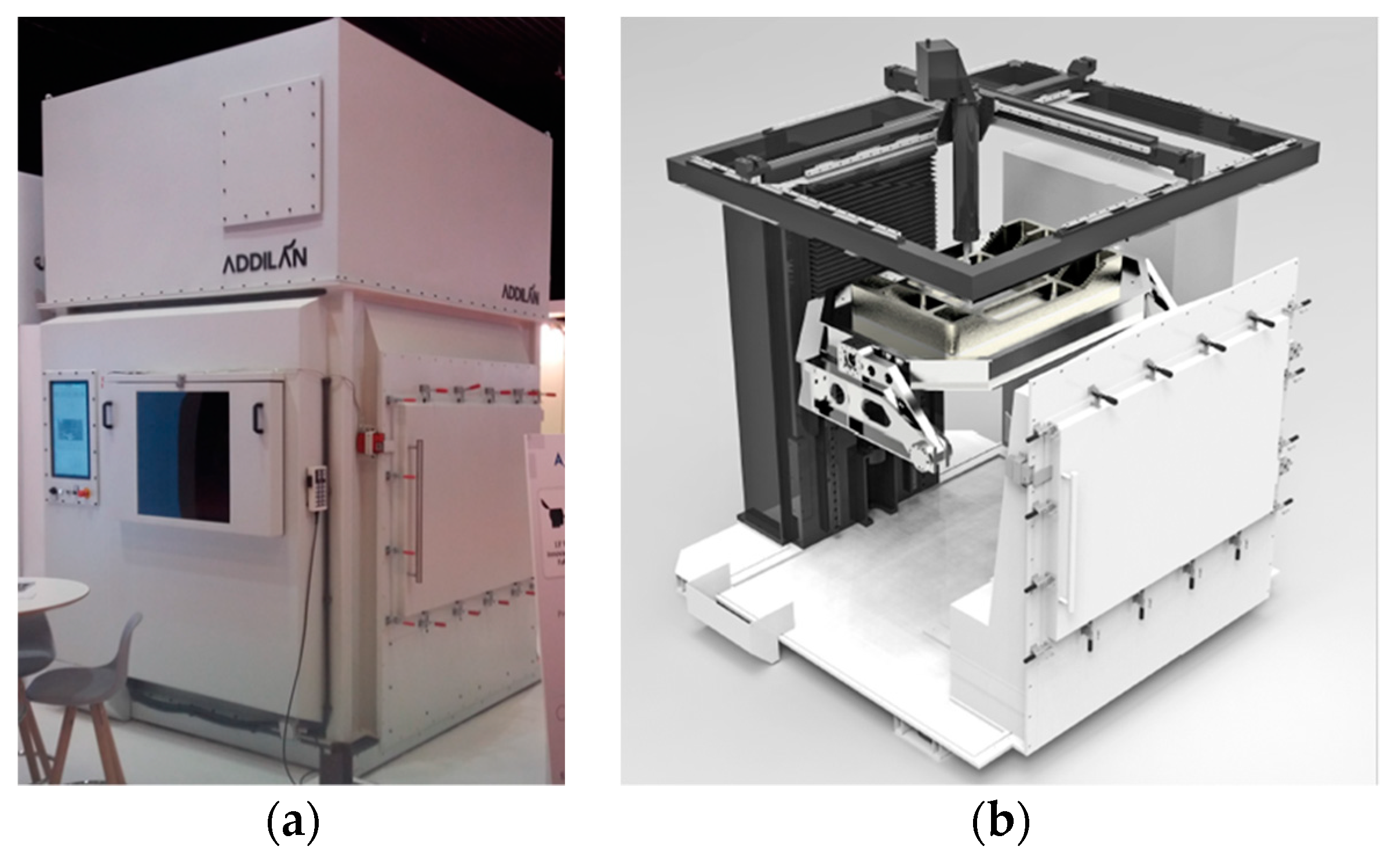

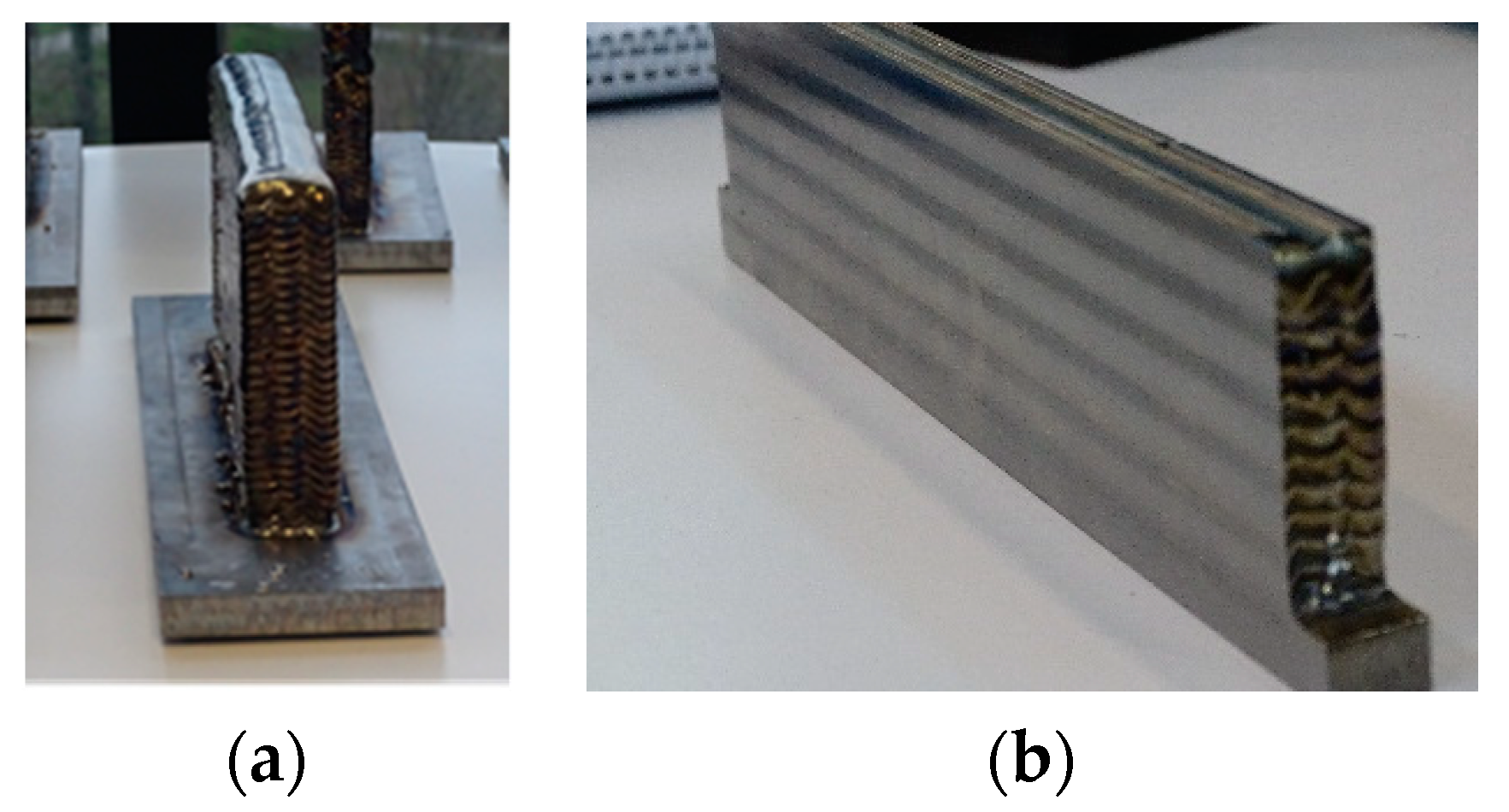
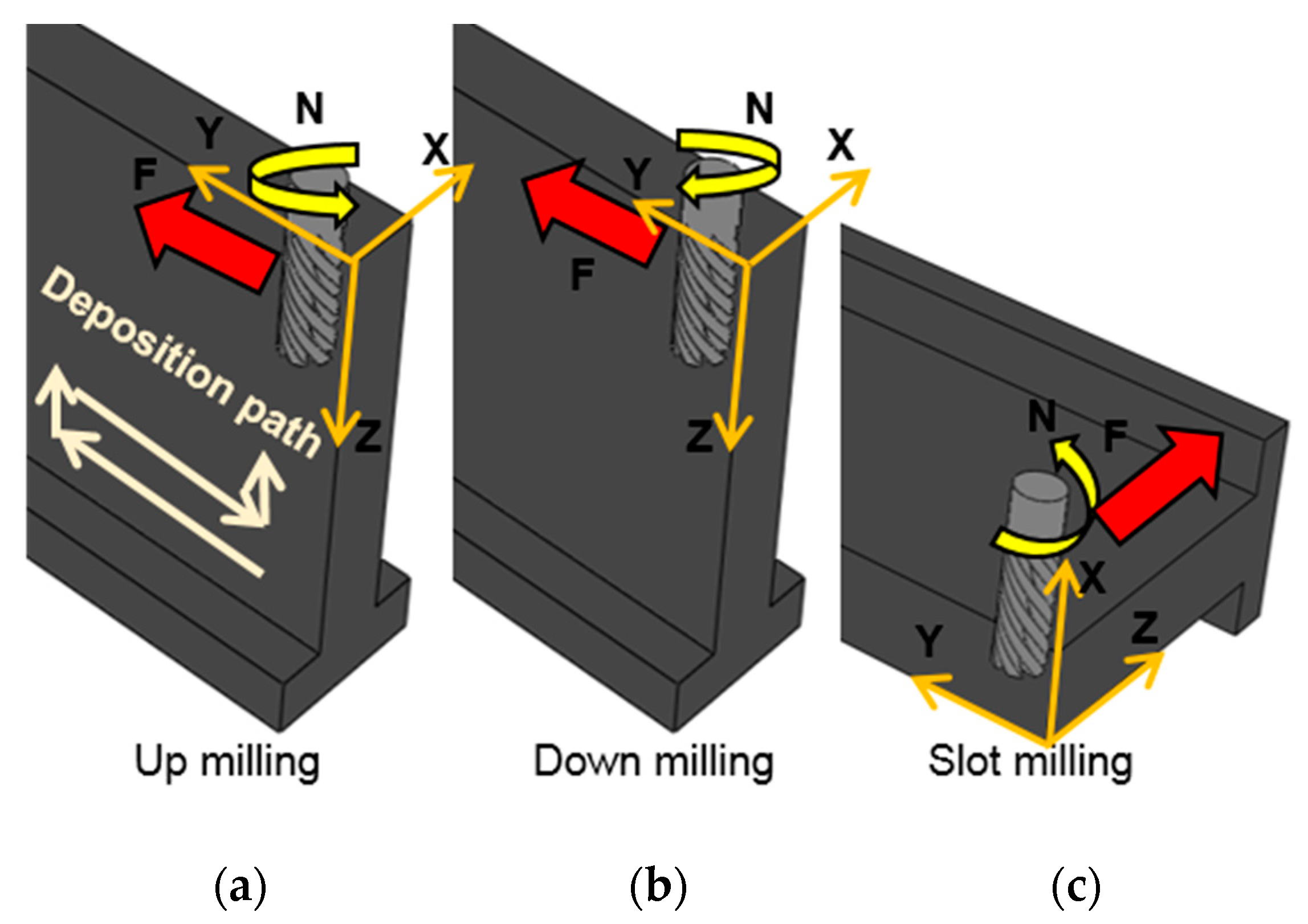
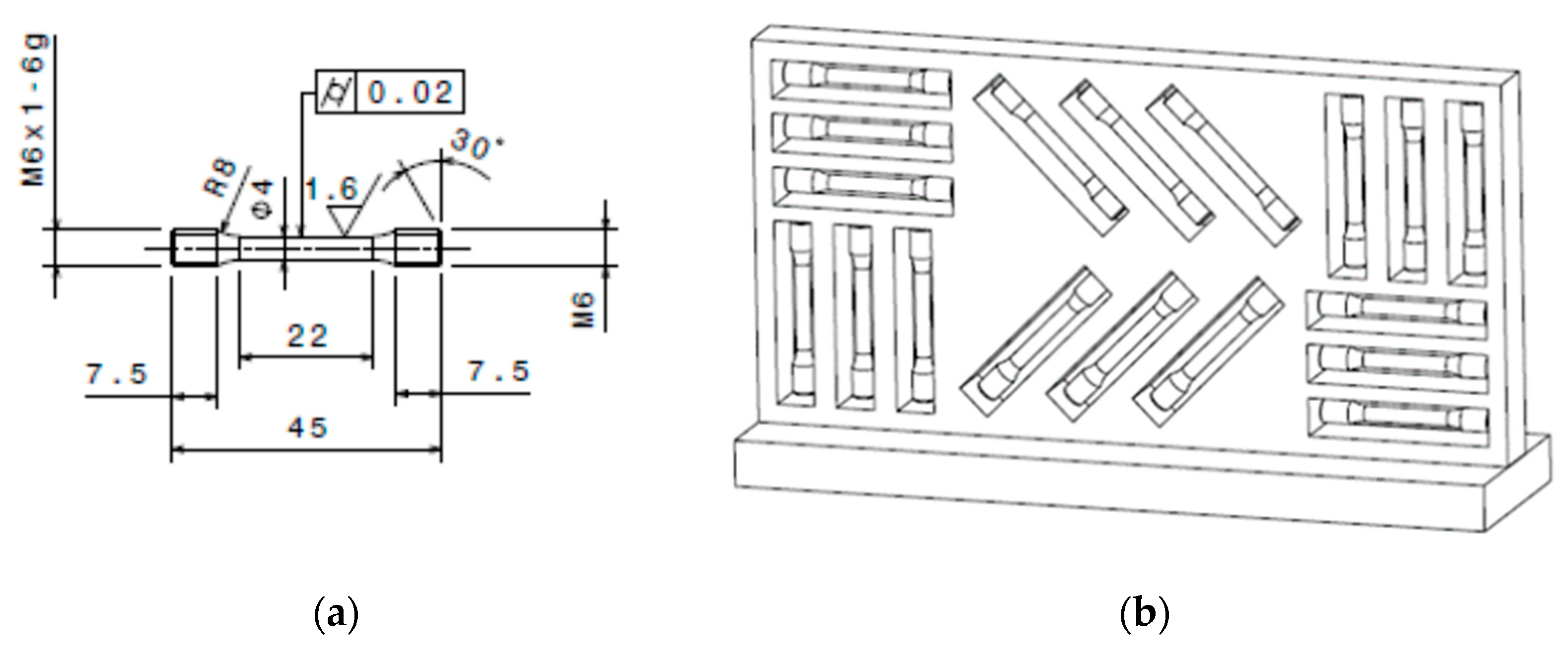
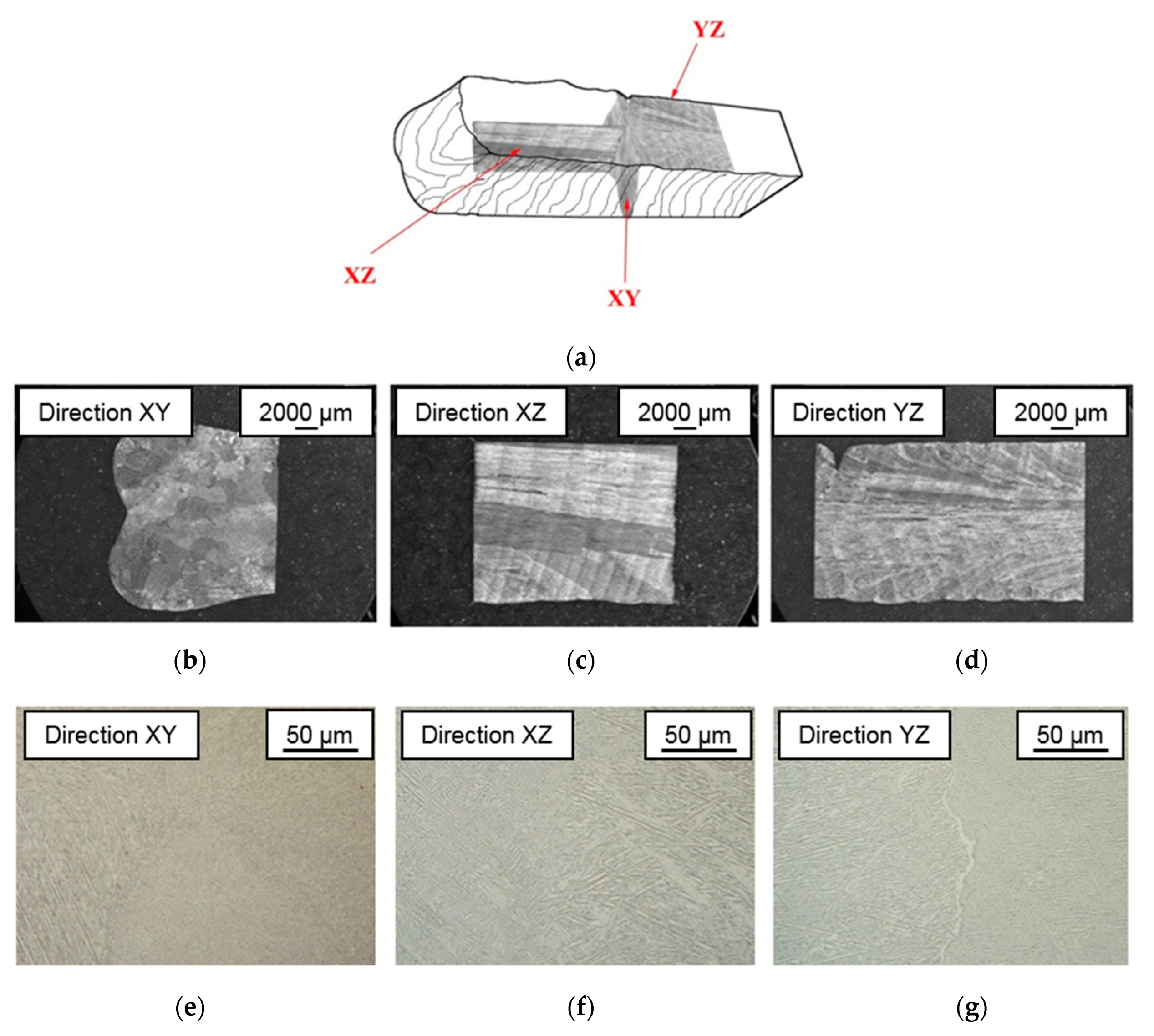
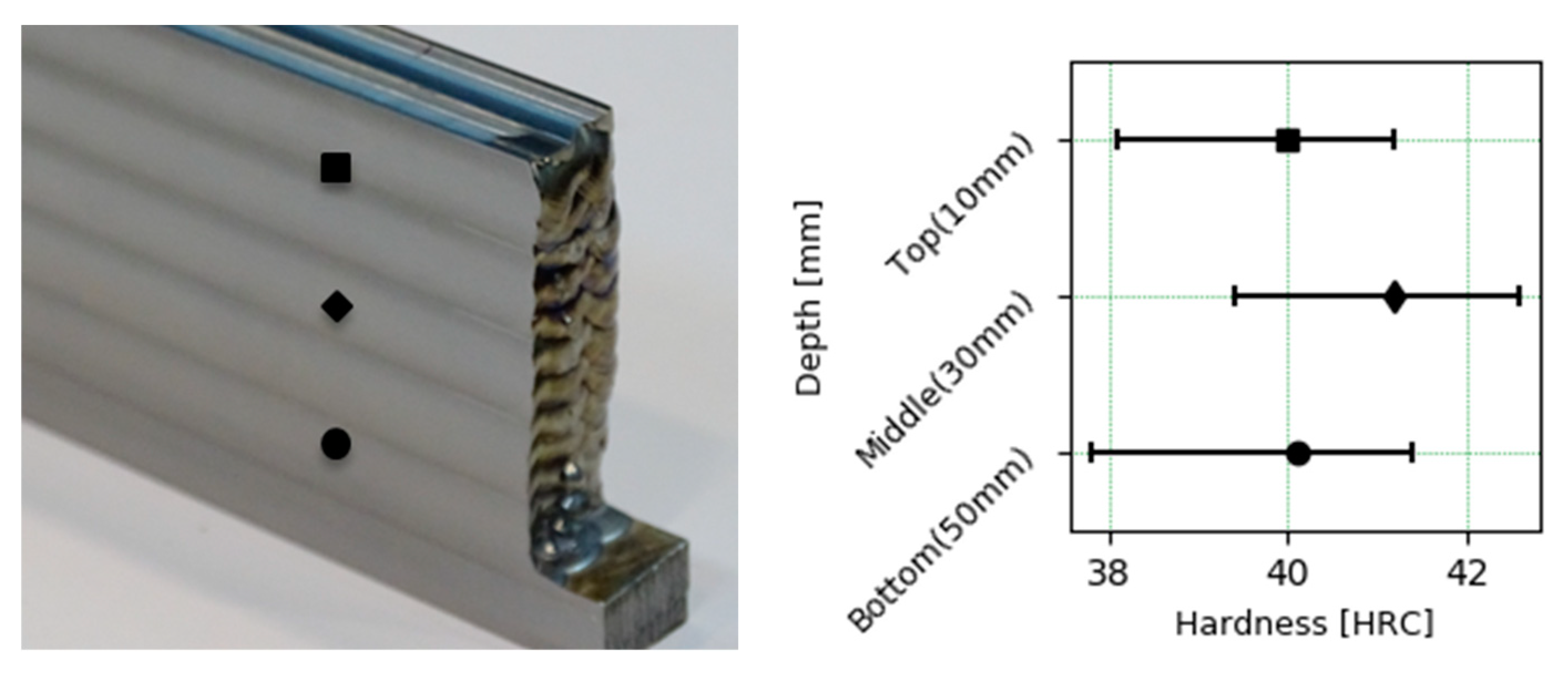
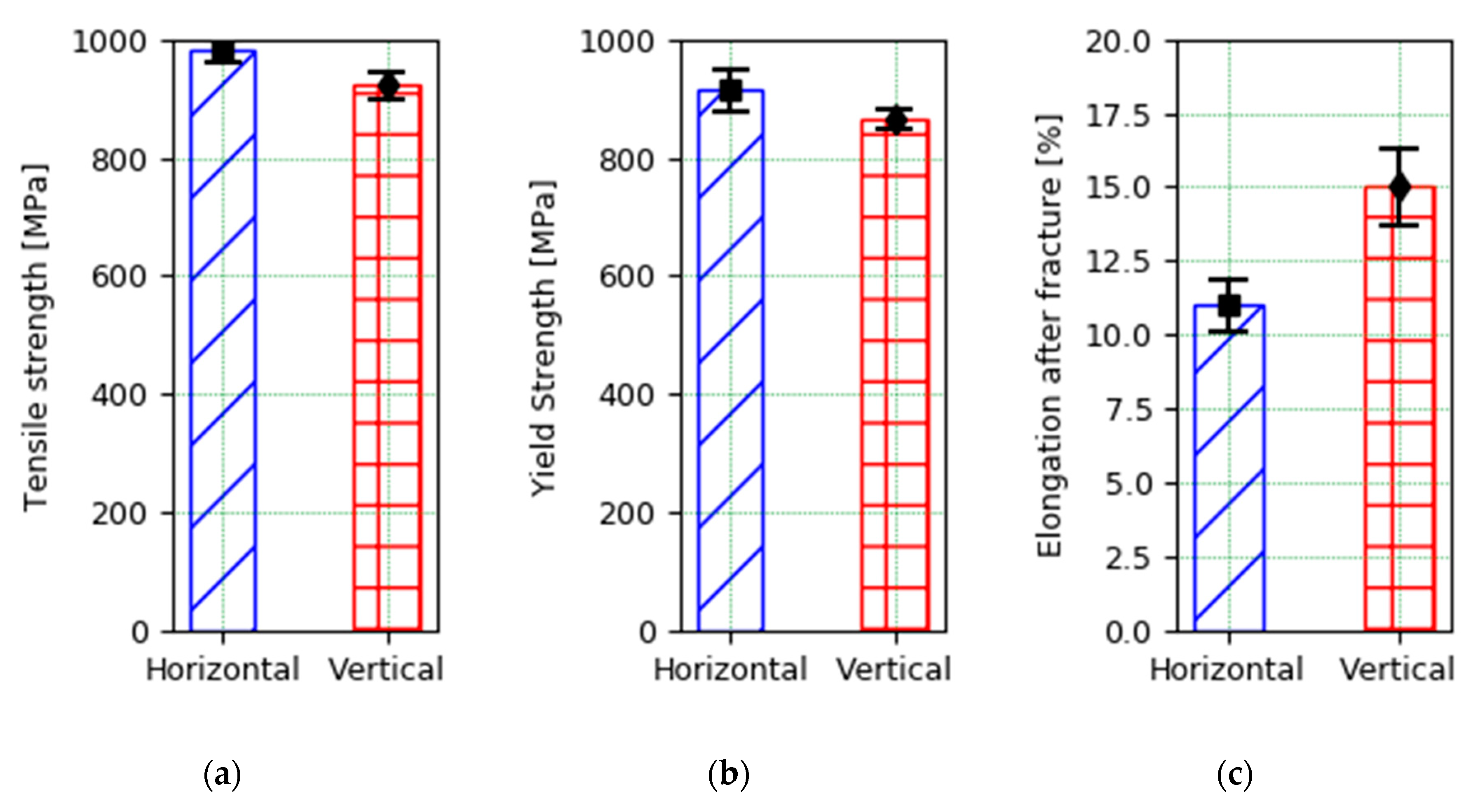
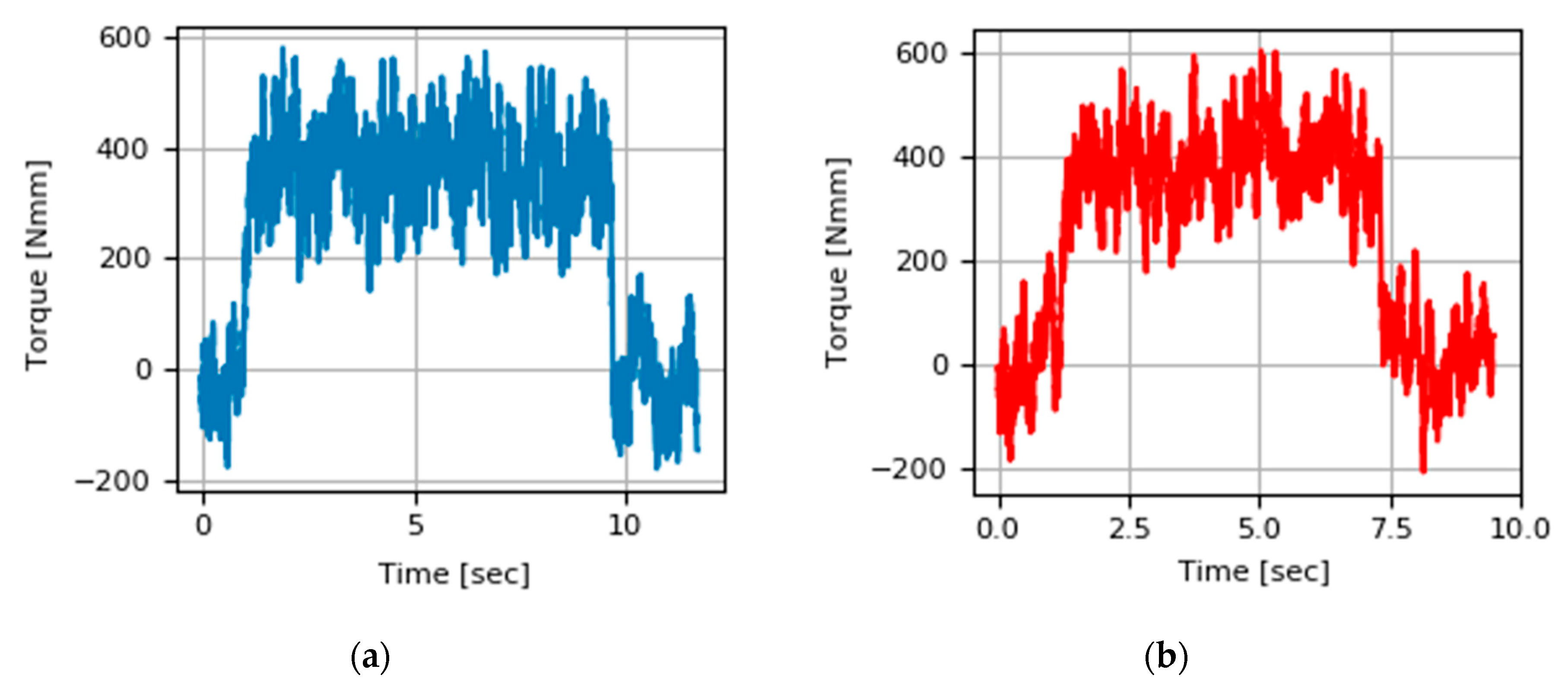
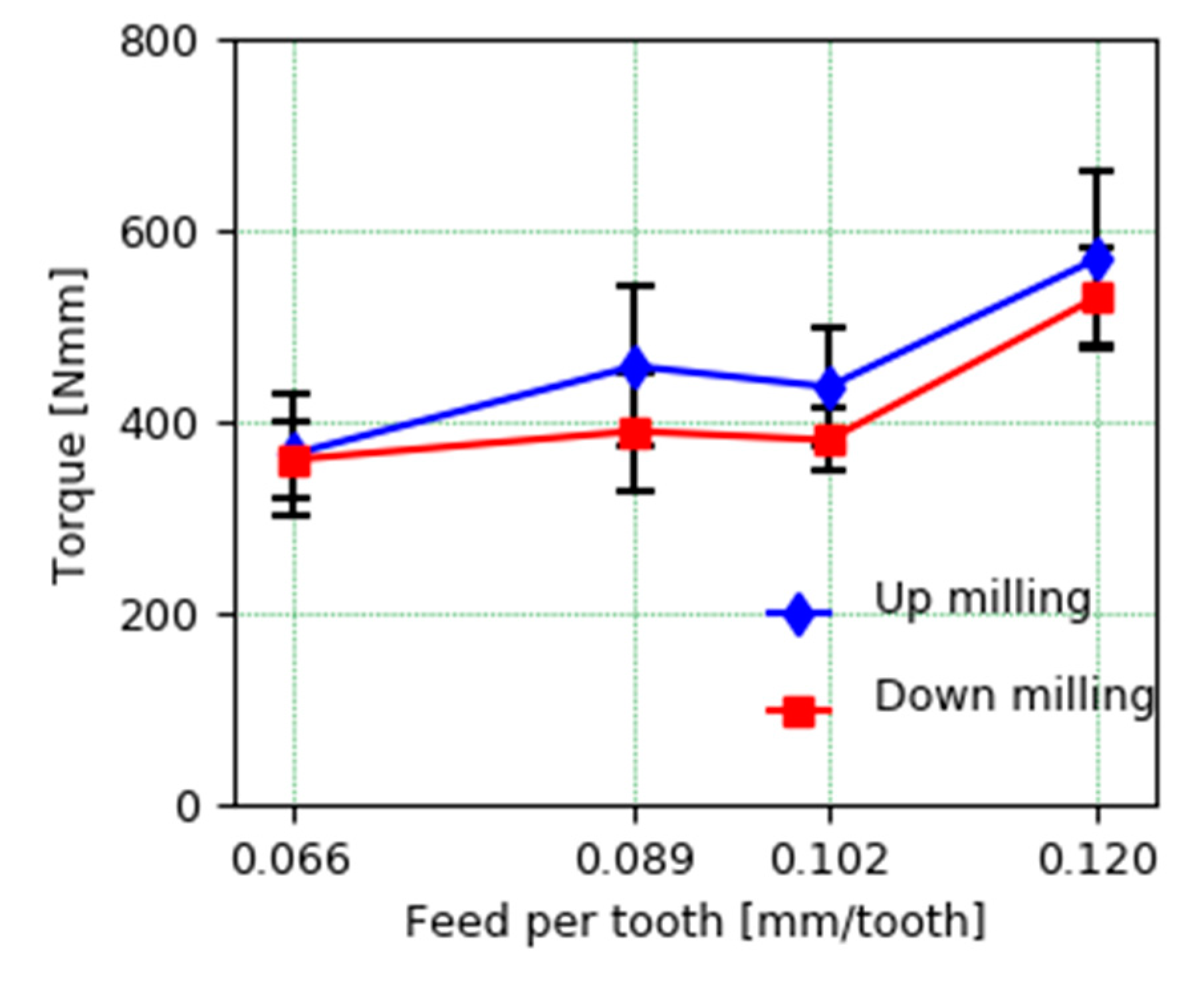
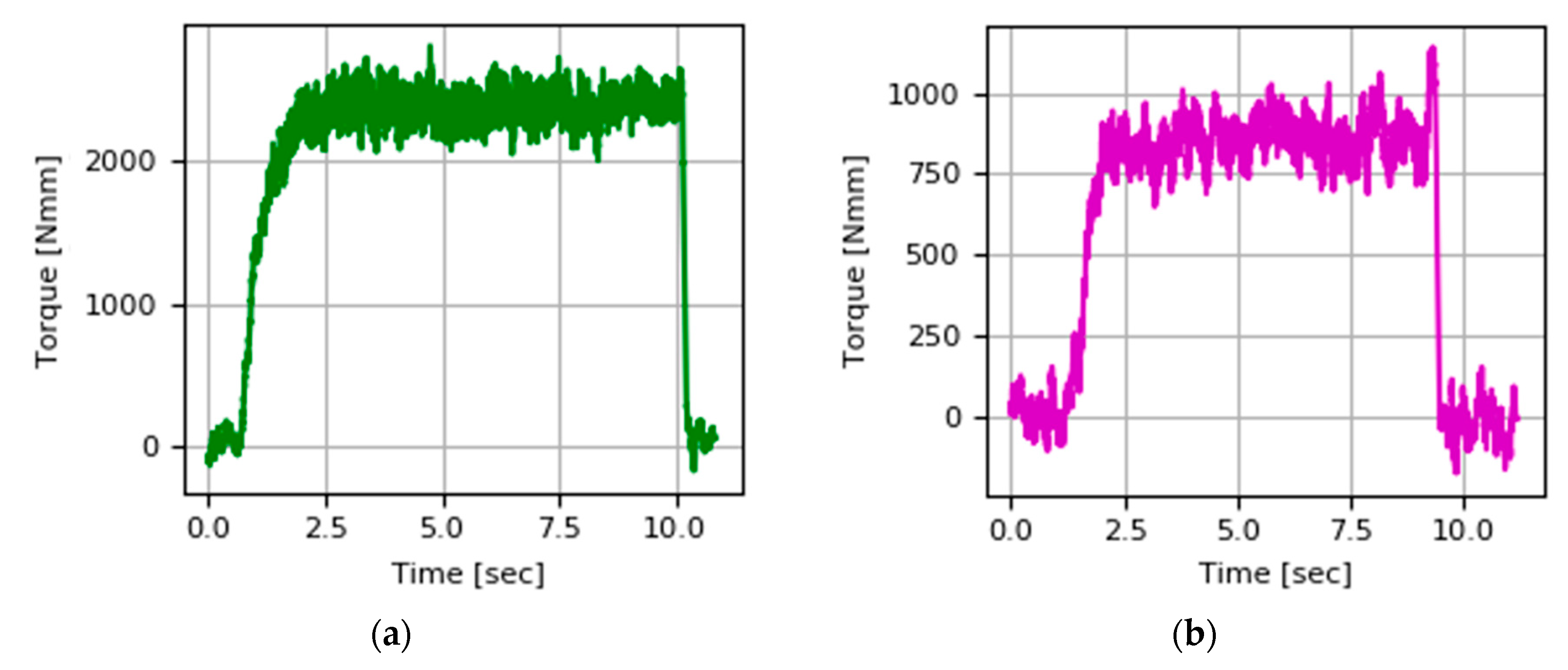
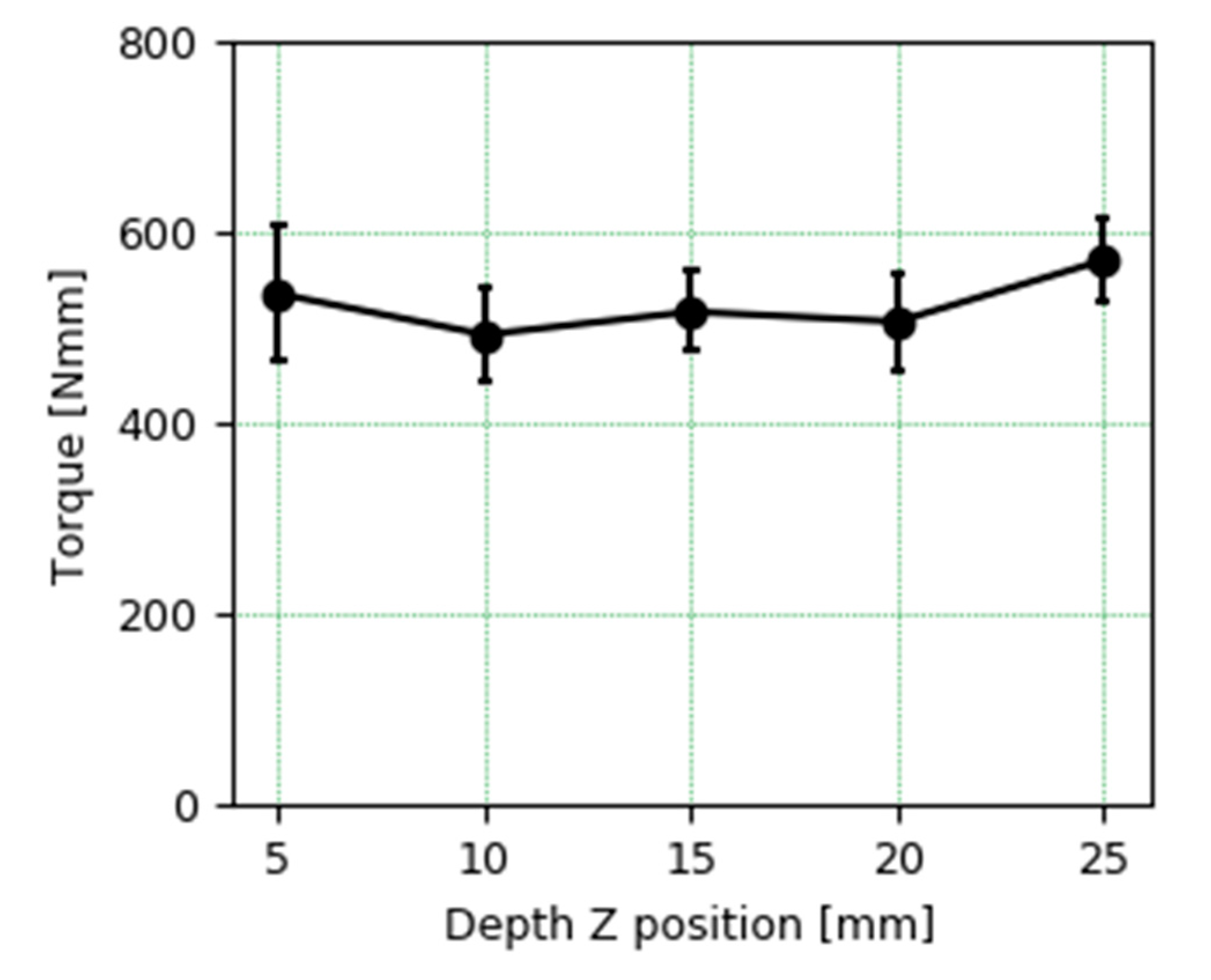
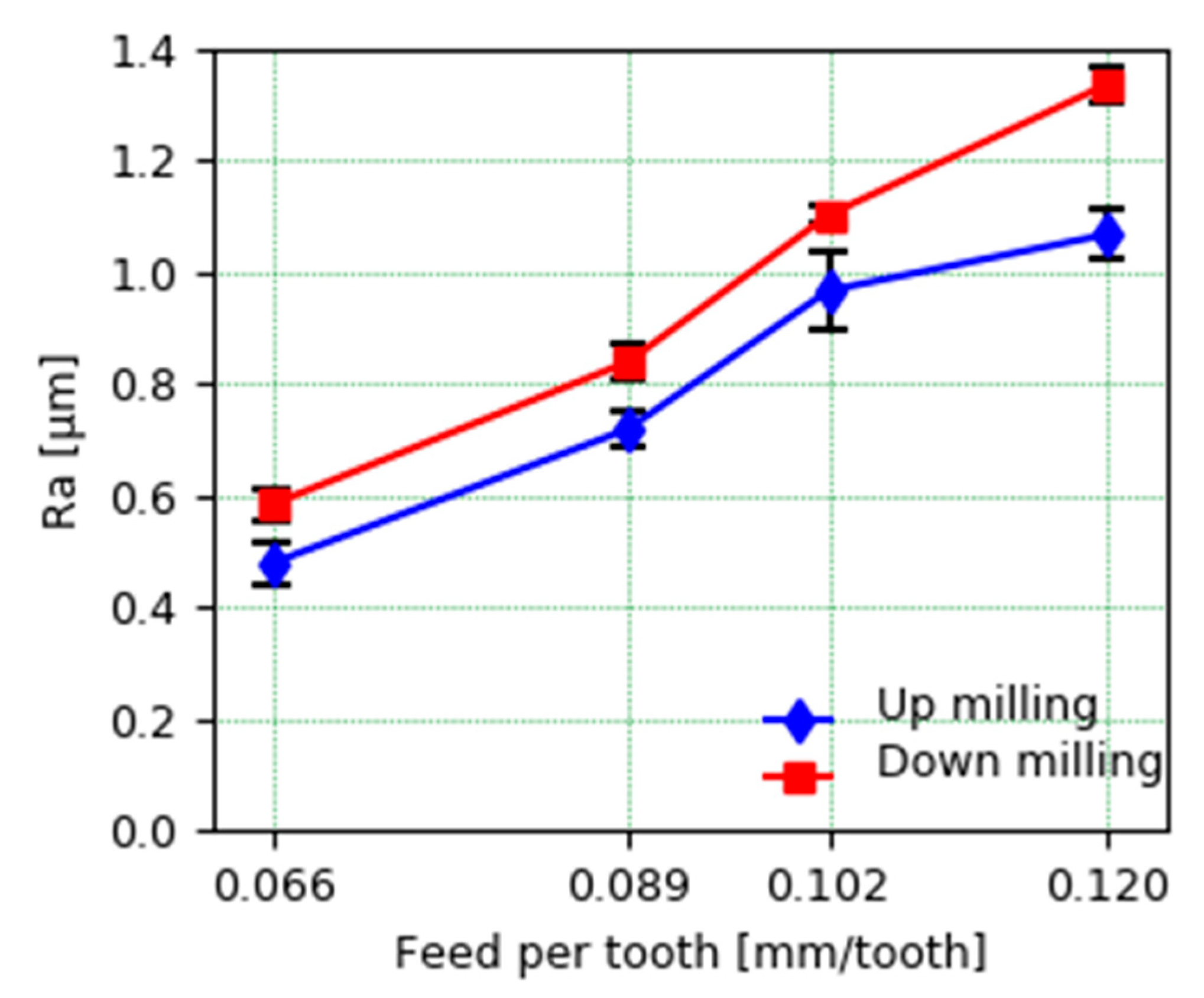
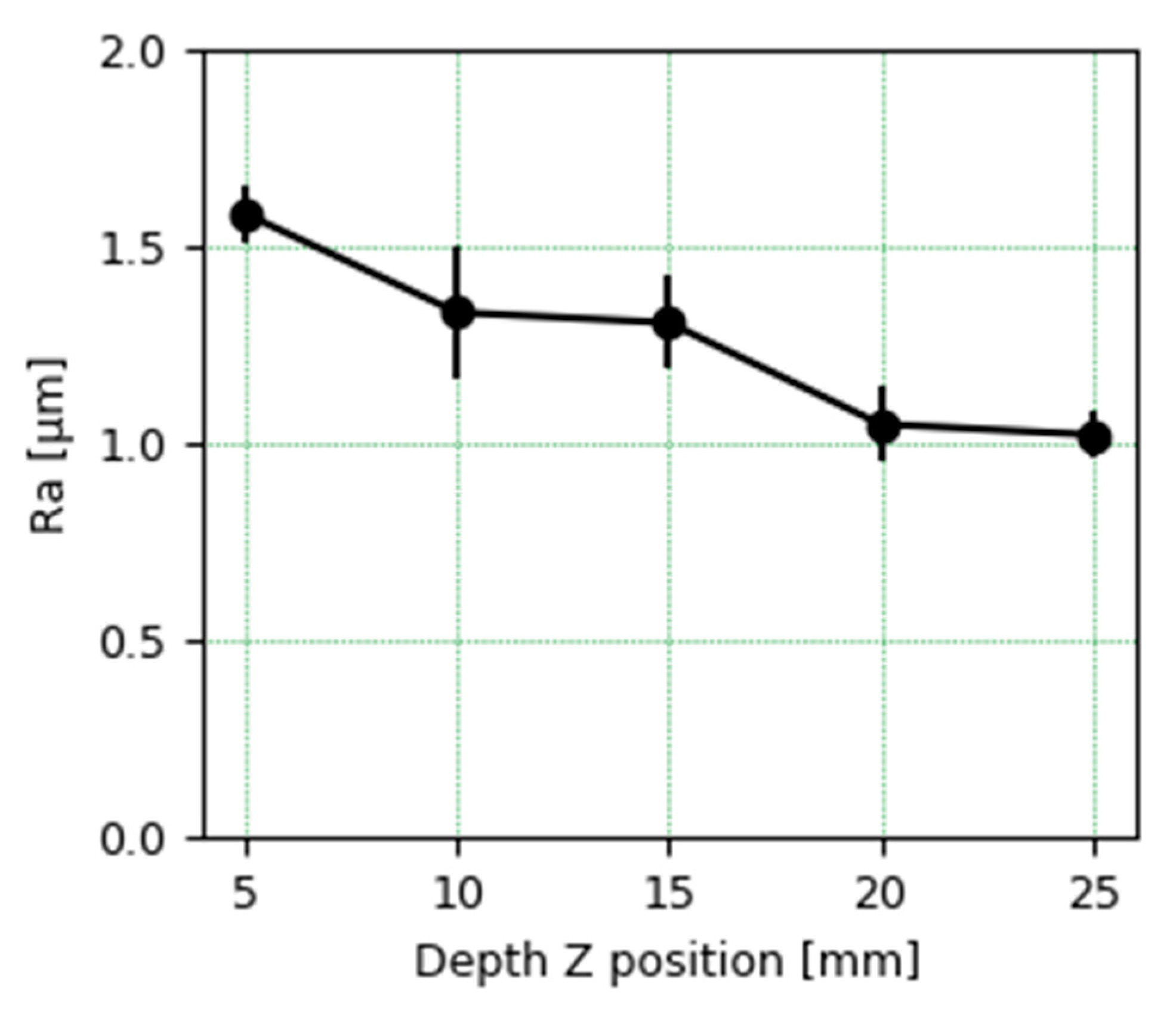
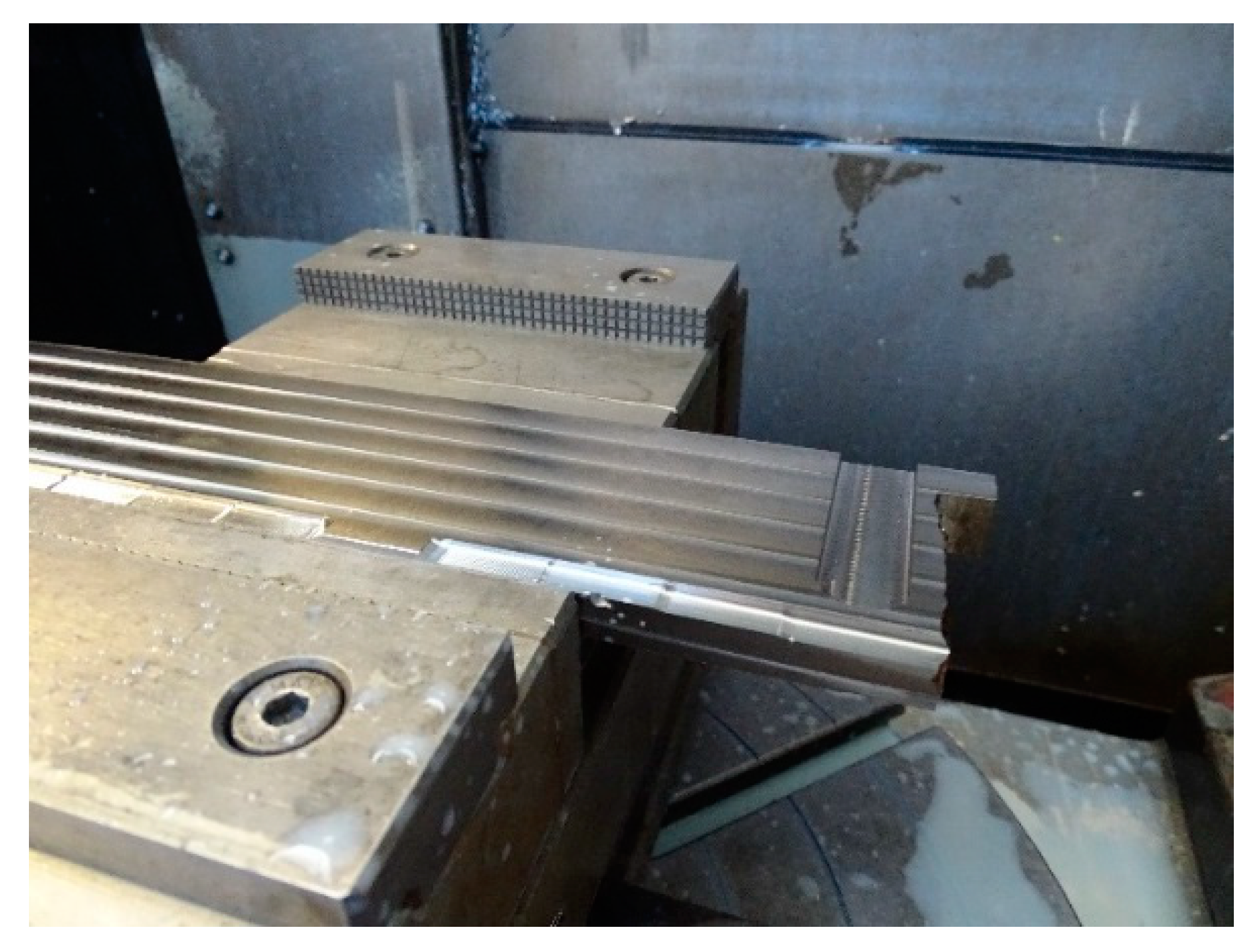

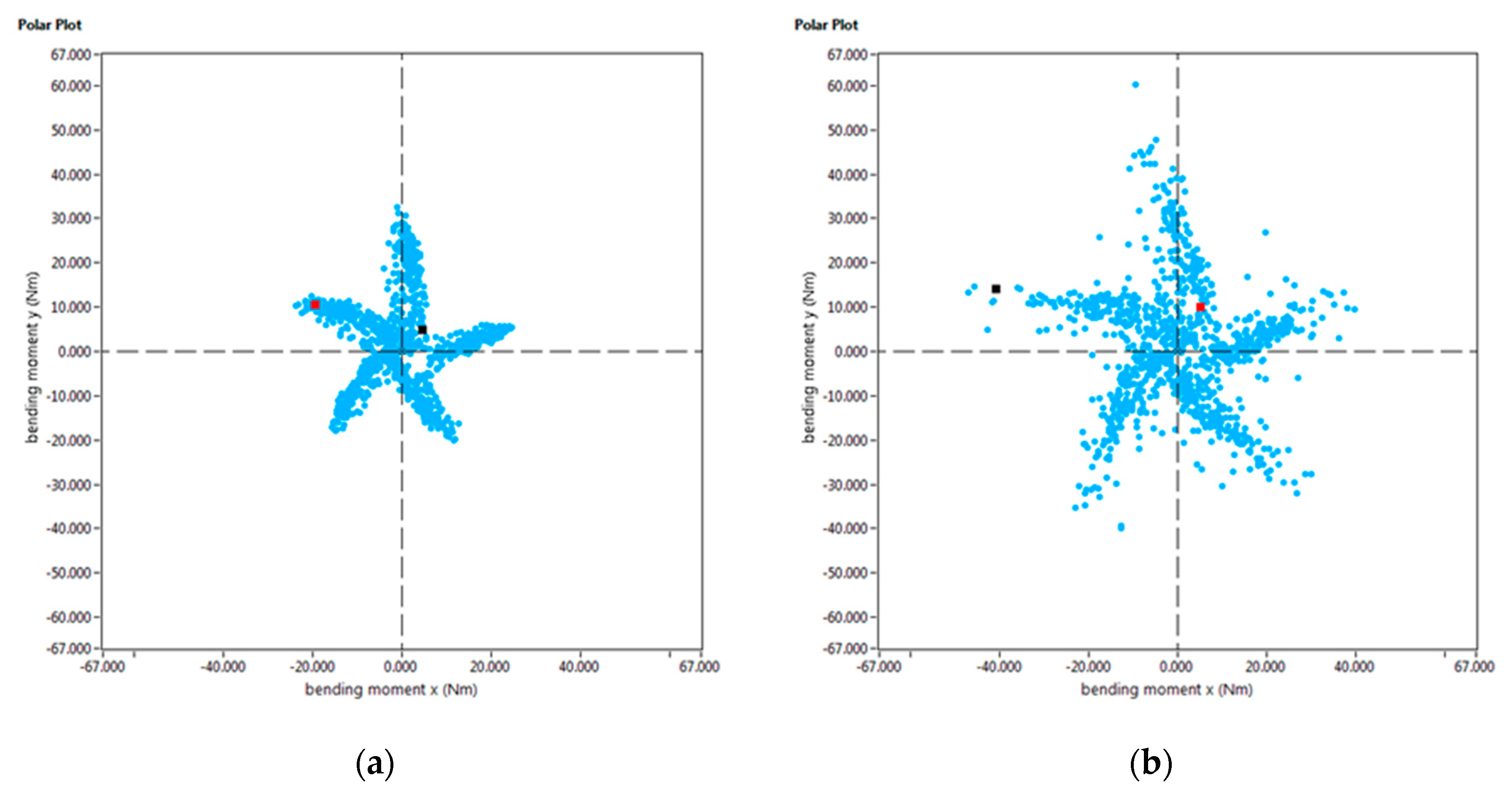
| C | O | N | H | Fe | Al | V |
|---|---|---|---|---|---|---|
| 0.02 | 0.16 | 0.011 | 0.0037 | 0.07 | 6.19 | 3.92 |
| Milling Strategy | ap | ae | fz | Vc |
|---|---|---|---|---|
| mm | mm | mm/tooth | m/min | |
| Up-milling/Down-milling | 5 | 0.4 | 0.066 | 60 |
| 0.084 | ||||
| 0.102 | ||||
| 0.12 | ||||
| Slot milling | 0.4 | 12 | 0.066 | 60 |
| Milling Strategy | ap | Ae | fz | Vc | Depth (Z Position) |
|---|---|---|---|---|---|
| mm | Mm | mm/tooth | m/min | Mm | |
| Up-milling | 5 | 0.4 | 0.12 | 60 | 5 |
| 10 | |||||
| 15 | |||||
| 20 |
| Milling Strategy | Ap | ae | fz | Vc |
|---|---|---|---|---|
| Mm | mm | mm/tooth | m/min | |
| Up-milling | 5 | 0.4 | 0.12 | 50 |
| Up-milling | 5 | 0.4 | 0.12 | 60 |
| Chemical Element | Ti6Al-4V | Ti6Al-4V PAW-WAAM | |
|---|---|---|---|
| min. | max. | ||
| C | 0 | 0.08 | 0.02 |
| O2 | 0 | 0.25 | 0.16 |
| N2 | 0 | 0.03 | 0.014 |
| H2 | 0 | 0.0125 | 0.003 |
| Fe | 0 | 0.3 | 0.17 |
| Al | 5.5 | 6.75 | 6.3 |
| V | 3.5 | 4.5 | 4 |
| Sample | UTS [MPa] | YS [MPa] | Elong [%] |
|---|---|---|---|
| Horizontal PAW-WAAM (PTH) | 981 ± 36 | 917 ± 19 | 11 ± 0.9 |
| Vertical PAW-WAAM (PTV) | 925 ± 18 | 864 ± 22 | 15 ± 1.3 |
| Ti6Al4V (AMS4928) | 931 | 862 | 10 |
© 2020 by the authors. Licensee MDPI, Basel, Switzerland. This article is an open access article distributed under the terms and conditions of the Creative Commons Attribution (CC BY) license (http://creativecommons.org/licenses/by/4.0/).
Share and Cite
Veiga, F.; Gil Del Val, A.; Suárez, A.; Alonso, U. Analysis of the Machining Process of Titanium Ti6Al-4V Parts Manufactured by Wire Arc Additive Manufacturing (WAAM). Materials 2020, 13, 766. https://doi.org/10.3390/ma13030766
Veiga F, Gil Del Val A, Suárez A, Alonso U. Analysis of the Machining Process of Titanium Ti6Al-4V Parts Manufactured by Wire Arc Additive Manufacturing (WAAM). Materials. 2020; 13(3):766. https://doi.org/10.3390/ma13030766
Chicago/Turabian StyleVeiga, Fernando, Alain Gil Del Val, Alfredo Suárez, and Unai Alonso. 2020. "Analysis of the Machining Process of Titanium Ti6Al-4V Parts Manufactured by Wire Arc Additive Manufacturing (WAAM)" Materials 13, no. 3: 766. https://doi.org/10.3390/ma13030766





